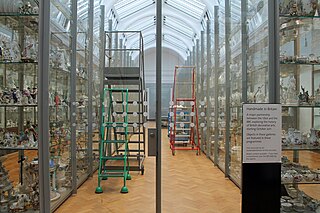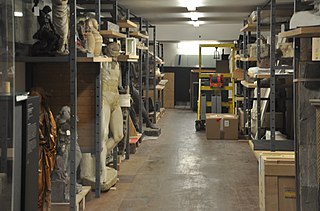
The conservation and restoration of cultural property focuses on protection and care of cultural property, including artworks, architecture, archaeology, and museum collections. Conservation activities include preventive conservation, examination, documentation, research, treatment, and education. This field is closely allied with conservation science, curators and registrars.

A museum is distinguished by a collection of often unique objects that forms the core of its activities for exhibitions, education, research, etc. This differentiates it from an archive or library, where the contents may be more paper-based, replaceable and less exhibition oriented, or a private collection of art formed by an individual, family or institution that may grant no public access. A museum normally has a collecting policy for new acquisitions, so only objects in certain categories and of a certain quality are accepted into the collection. The process by which an object is formally included in the collection is called accessioning and each object is given a unique accession number.

In conservation, library and archival science, preservation is a set of preventive conservation activities aimed at prolonging the life of a record, book, or object while making as few changes as possible. Preservation activities vary widely and may include monitoring the condition of items, maintaining the temperature and humidity in collection storage areas, writing a plan in case of emergencies, digitizing items, writing relevant metadata, and increasing accessibility. Preservation, in this definition, is practiced in a library or an archive by a conservator, librarian, archivist, or other professional when they perceive a collection or record is in need of maintenance.

With respect to cultural property, conservation science is the interdisciplinary study of the conservation of art, architecture, technical art history and other cultural works through the use of scientific inquiry. General areas of research include the technology and structure of artistic and historic works. In other words, the materials and techniques from which cultural, artistic and historic objects are made.

A conservator-restorer is a professional responsible for the preservation of artistic and cultural artifacts, also known as cultural heritage. Conservators possess the expertise to preserve cultural heritage in a way that retains the integrity of the object, building or site, including its historical significance, context and aesthetic or visual aspects. This kind of preservation is done by analyzing and assessing the condition of cultural property, understanding processes and evidence of deterioration, planning collections care or site management strategies that prevent damage, carrying out conservation treatments, and conducting research. A conservator's job is to ensure that the objects in a museum's collection are kept in the best possible condition, as well as to serve the museum's mission to bring art before the public.

Conservation and restoration of metals is the activity devoted to the protection and preservation of historical and archaeological objects made partly or entirely of metal. In it are included all activities aimed at preventing or slowing deterioration of items, as well as improving accessibility and readability of the objects of cultural heritage. Despite the fact that metals are generally considered as relatively permanent and stable materials, in contact with the environment they deteriorate gradually, some faster and some much slower. This applies especially to archaeological finds.
Conservation and restoration of movable cultural property is a term used to denote the conservation of movable cultural property items in libraries, archives, museums and private collections. Conservation encompasses all the actions taken toward the long-term preservation of cultural heritage. Activities include examination, documentation, treatment, and preventive care, which is supported by research and education. Object conservation is specifically the actions taken to preserve and restore cultural objects. The objects span a wide range of materials from a variety of cultures, time periods, and functions. Object conservation can be applied to both art objects and artifacts. Conservation practice aims to prevent damage from occurring, a process known as 'preventive conservation'. The purpose of preventive conservation is to maintain, and where possible enhance, the condition of an object, as well as managing deterioration risks, such as handling and environmental conditions. Historically, object conservation was focused on the category of fine arts but now many different types of objects are conserved. Each type of object material, typically denoted by organic or inorganic then the specific medium, requires a specialized professional conservator and often requires collaborative work between museum staff, scientists, and conservators.

Collection maintenance is an area of collections management that consists of the day-to-day hands on care of collections and cultural heritage. The primary goal of collections maintenance or preventive conservation is to prevent further decay of cultural heritage by ensuring proper storage and upkeep including performing regular housekeeping of the spaces and objects and monitoring and controlling storage and gallery environments. Collections maintenance is part of the risk management field of collections management. The professionals most involved with collections maintenance include collection managers, registrars, and archivists, depending on the size and scope of the institution. Collections maintenance takes place in two primary areas of the museum: storage areas and display areas.

Collections management involves the development, storage, and preservation of cultural property, as well as objects of contemporary culture in museums, libraries, archives and private collections. The primary goal of collections management is to meet the needs of the individual collector or collecting institution's mission statement, while also ensuring the long-term safety and sustainability of the cultural objects within the collector's care. Collections management, which consists primarily of the administrative responsibilities associated with collection development, is closely related to collections care, which is the physical preservation of cultural heritage. The professionals most influenced by collections management include collection managers, registrars, and archivists.

An Objects conservator is a professional, working in a museum setting or private practice, that specializes in the conservation of three-dimensional works. They undergo specialized education, training, and experience that allows them to formulate and implement preventive strategies and invasive treatment protocols to preserve cultural property for the future. Objects conservators typically specialize in one type of material or class of cultural property, including metals, archaeological artifacts, ethnographic artifacts, glass, and ceramic art. Objects conservation presents many challenges due to their three-dimensional form and composite nature.

Disaster preparedness in museums, galleries, libraries, archives and private collections, involves any actions taken to plan for, prevent, respond or recover from natural disasters and other events that can cause damage or loss to cultural property. 'Disasters' in this context may include large-scale natural events such as earthquakes, flooding or bushfire, as well as human-caused events such as theft and vandalism. Increasingly, anthropogenic climate change is a factor in cultural heritage disaster planning, due to rising sea levels, changes in rainfall patterns, warming average temperatures, and more frequent extreme weather events.

Conservation and restoration of objects made from plastics is work dedicated to the conservation of objects of historical and personal value made from plastics. When applied to cultural heritage, this activity is generally undertaken by a conservator-restorer.

A photograph conservator is a professional who examines, documents, researches, and treats photographs, including documenting the structure and condition of art works through written and photographic records, monitoring conditions of works in storage and exhibition and transit environments. This person also performs all aspects of the treatment of photographs and related artworks with adherence to the professional Code of Ethics.

The conservation and restoration of Tibetan thangkas is the physical preservation of the traditional religious Tibetan painting form known as a thangka. When applied to thangkas of significant cultural heritage, this activity is generally undertaken by a conservator-restorer.

The cultural property storage typically falls to the responsibility of cultural heritage institutions, or individuals. The proper storage of these objects can help to ensure a longer lifespan for the object with minimal damage or degradation. With so many different types of artifacts, materials, and combinations of materials, keepers of these artifacts often have considerable knowledge of the best practices in storing these objects to preserve their original state.

The conservation and restoration of feathers is the practice of maintaining and preserving feathers or featherwork objects, and requires knowledge of feather anatomy, properties, specialized care procedures, and environmental influences. This practice may be approached through preventive and/or interventive techniques.

The conservation and restoration of paintings is carried out by professional painting conservators. Paintings cover a wide range of various mediums, materials, and their supports. Painting types include fine art to decorative and functional objects spanning from acrylics, frescoes, and oil paint on various surfaces, egg tempera on panels and canvas, lacquer painting, water color and more. Knowing the materials of any given painting and its support allows for the proper restoration and conservation practices. All components of a painting will react to its environment differently, and impact the artwork as a whole. These material components along with collections care will determine the longevity of a painting. The first steps to conservation and restoration is preventive conservation followed by active restoration with the artist's intent in mind.
The conservation-restoration of panel paintings involves preventive and treatment measures taken by paintings conservators to slow deterioration, preserve, and repair damage. Panel paintings consist of a wood support, a ground, and an image layer. They are typically constructed of two or more panels joined together by crossbeam braces which can separate due to age and material instability caused by fluctuations in relative humidity and temperature. These factors compromise structural integrity and can lead to warping and paint flaking. Because wood is particularly susceptible to pest damage, an IPM plan and regulation of the conditions in storage and display are essential. Past treatments that have fallen out of favor because they can cause permanent damage include transfer of the painting onto a new support, planing, and heavy cradling. Today's conservators often have to remediate damage from previous restoration efforts. Modern conservation-restoration techniques favor minimal intervention that accommodates wood's natural tendency to react to environmental changes. Treatments may include applying flexible battens to minimize deformation or simply leaving distortions alone, instead focusing on preventive care to preserve the artwork in its original state.

The conservation and restoration of wooden artifacts refers to the preservation of art and artifacts made of wood. Conservation and restoration in regards to cultural heritage is completed by a conservator-restorer.

The 'ten agents of deterioration' are a conceptual framework developed by the Canadian Conservation Institute (CCI) used to categorise the major causes of change, loss or damage to cultural heritage objects. Also referred to as the 'agents of change', the framework was first developed in the late 1980s and early 1990s. The defined agents reflect and systematise the main chemical and physical deterioration pathways to which most physical material is subject. They are a major influence on the applied practice of conservation, restoration, and collection management, finding particular use in risk management for cultural heritage collections.

















